Clock Distribution Techniques
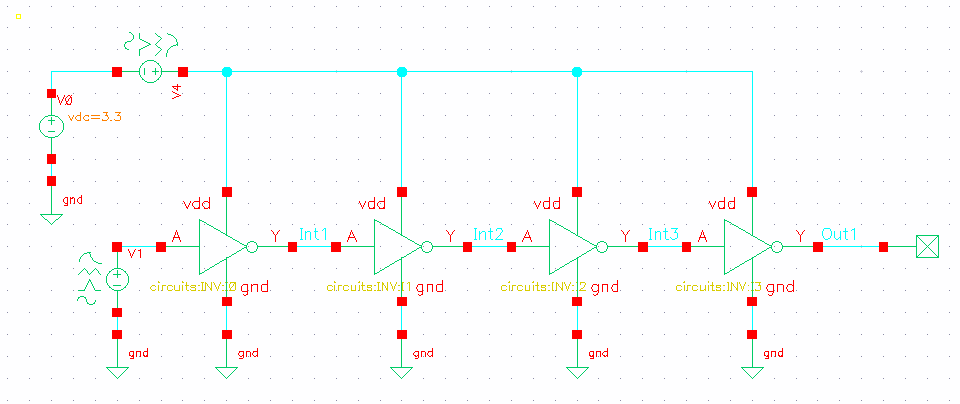
Deterministic Jitter
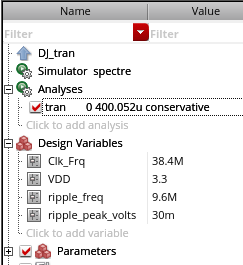

j_Djpp can be calculated by PSD,too
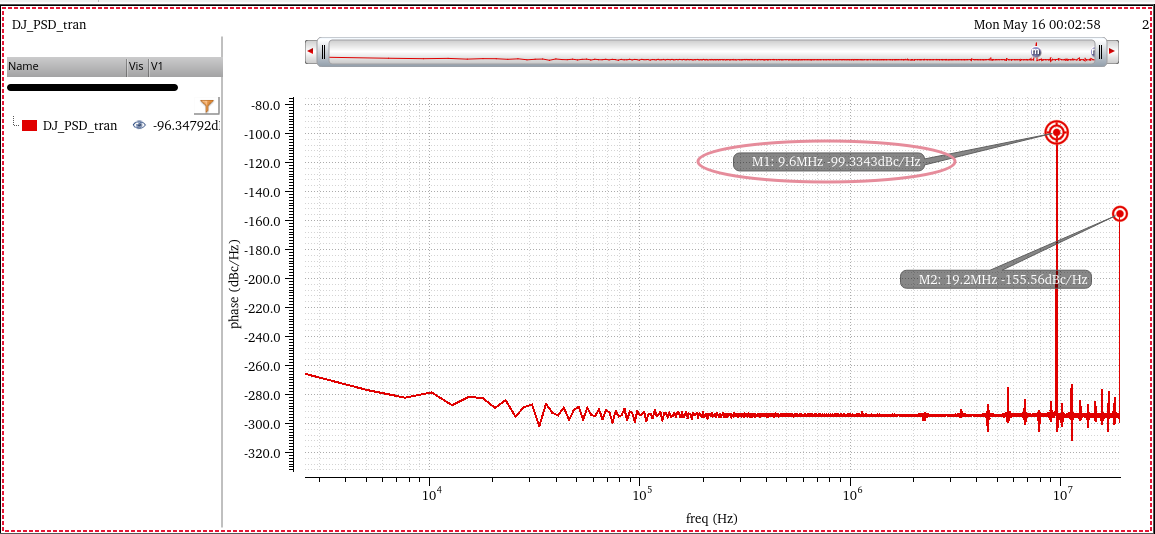
1 | fck = 38.4e6; |
1 | Jpp = |
For DJ, we usually use peak to peak value
BTW, the psd value at half of fundamental frequency (\(f_s/2\)) is
duty cycle distortion due to the NMOS/PMOS imbalance, because of rising only data
Random Jitter
RJ can be accurately and efficiently measured using PSS/Pnoise or HB/HBnoise.
Note that the transient noise can also be used to compute RJ;
However, the computation cost is typically very high, and the accuracy is lesser as compared to PSS/Pnoise and HB/HBnoise.
Since RJ follows a Gaussian distribution, it can be fully characterized using its Root-Mean-Squared value (RMS) or the standard deviation value (\(\sigma\))
The Peak-to-Peak value of RJ (\(\text{RJ}_{\text{p-p}}\)) can be calculated under certain observation conditions \[ \text{RJ}_{\text{p-p}}\equiv K \ast \text{RJ}_{\text{RMS}} \] Here, \(K\) is a constant determined by the BER specification of the system given in the following Table
| BER | Crest factor (K) |
|---|---|
| \(10^{-3}\) | 6.18 |
| \(10^{-4}\) | 7.438 |
| \(10^{-5}\) | 8.53 |
| \(10^{-6}\) | 9.507 |
| \(10^{-7}\) | 10.399 |
| \(10^{-8}\) | 11.224 |
| \(10^{-9}\) | 11.996 |
| \(10^{-10}\) | 12.723 |
| \(10^{-11}\) | 13.412 |
| \(10^{-12}\) | 14.069 |
| \(10^{-13}\) | 14.698 |
1 | K = 14.698; |
1 | BER = |
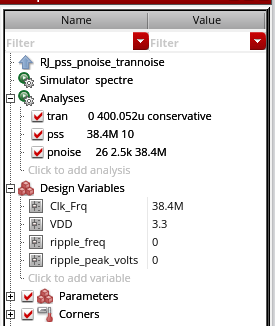
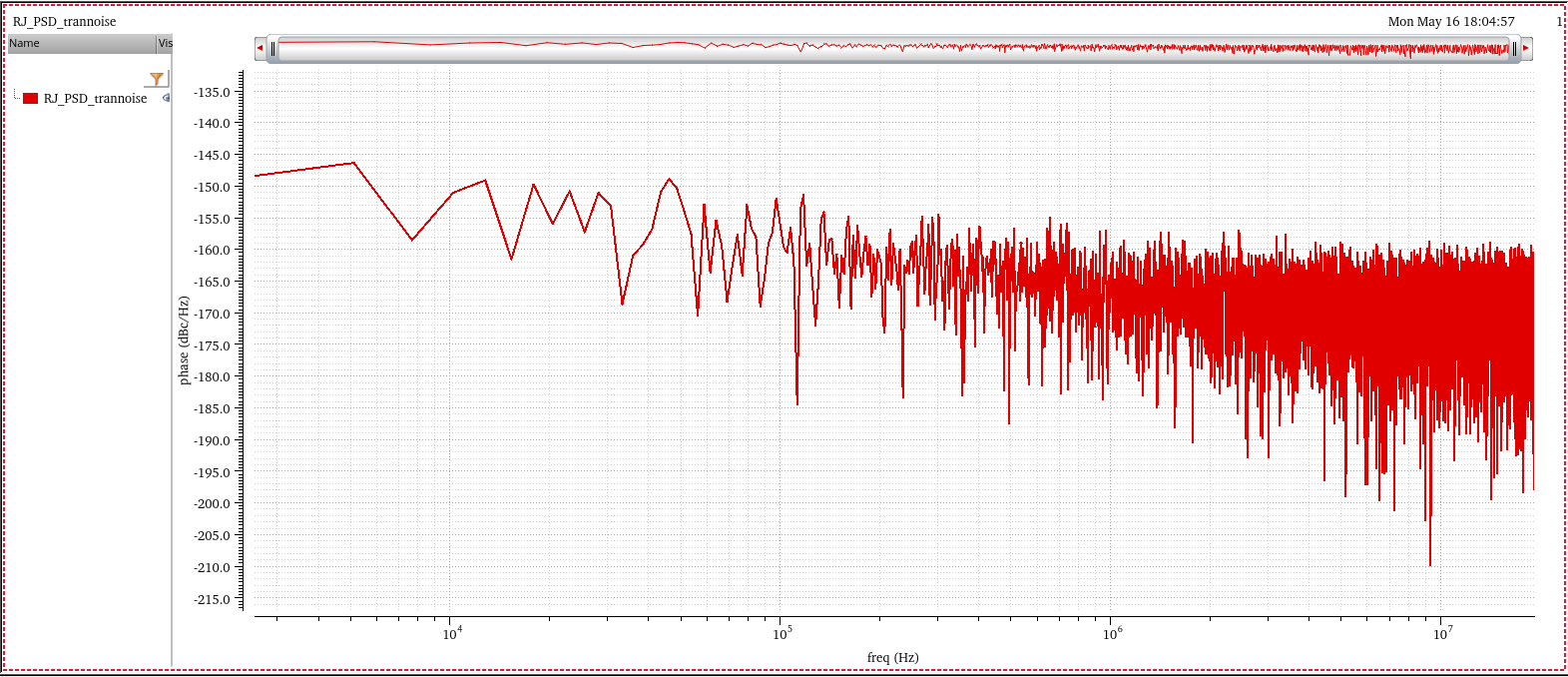
Total Jitter
\[ \text{TJ}_{\text{p-p}}\equiv \text{DJ}_{\text{p-p}} + \text{RJ}_{\text{p-p}}(\text{BER}) \]
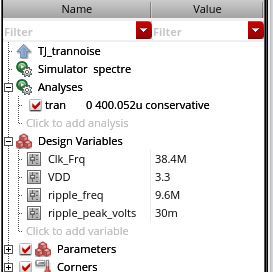
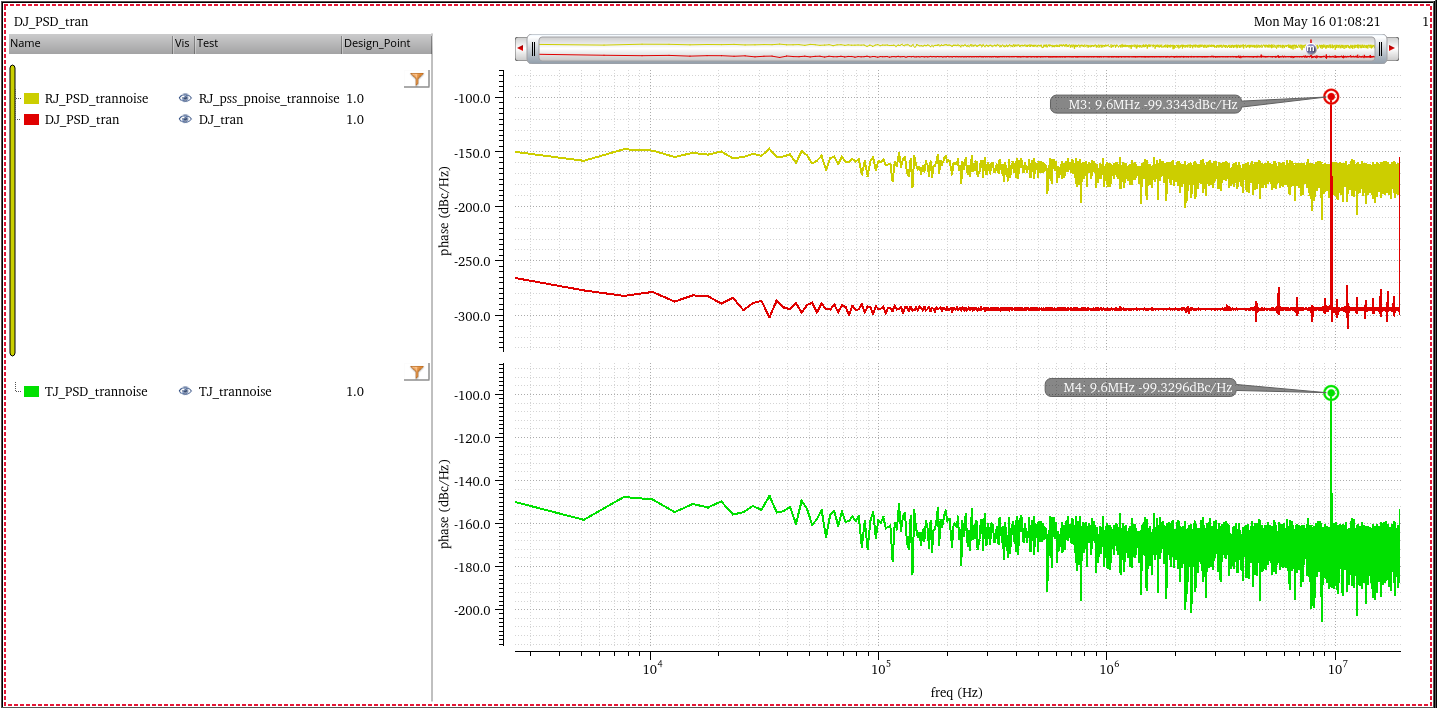
In the psd of TJ, the spur is DJ and floor is RJ
Phase Noise to Jitter
The phase noise is traditionally defined as the ratio of the power of the signal in 1Hz bandwidth at offset \(f\) from the carrier \(P\), divided by the power of the carrier \[ \ell (f) = \frac {S_v'(f_0+f)}{P} \] where \(S_v'\) is is one-sided voltage PSD and \(f \geqslant 0\)
Under narrow angle assumption \[ S_{\varphi}(f)= \frac {S_v'(f_0+f)}{P} \] where \(\forall f\in \left[-\infty +\infty\right]\)
Using the Wiener-Khinchin theorem, it is possible to easily derive the variance of the absolute jitter(\(J_{ee}\))via integration of the corresponding PSD \[ J_{ee,rms}^2 = \int S_{J_{ee}}(f)df \]
And we know the relationship between absolute jitter and excess phase is \[ J_{ee}=\frac {\varphi}{\omega_0} \] Considering that phase noise is normally symmetrical about the zero frequency, multiplied by two is shown as below \[ J_{ee,rms} = \frac{\sqrt{2\int_{0}^{+\infty}\ell(f)df}}{\omega_0} \] where phase noise is in linear units not in logarithmic ones.
Because the unit of phase noise in Spectre-RF is logarithmic unit (dBc), we have to convert the unit before applying the above equation \[ \ell[linear] = 10^{\frac {\ell [dBc/Hz]}{10}} \] The complete equation using the simulation result of Spectre-RF Pnoise is \[ J_{ee,rms} = \frac{\sqrt{2\int_{0}^{+\infty}10^{\frac {\ell [dBc/Hz]}{10}}df}}{\omega_0} \]
The above equation has been verified for sampled pnoise, i.e. Jee and Edge Phase Noise.
- For pnoise-sampled(jitter), Direct Plot Form - Function: Jee:Integration Limits can calculate it conveniently
- But for pnoise-timeaveage, you have to use the below equation to get RMS jitter.
One example, integrate to \(\frac{f_{osc}}{2}\) and \(f_{osc} = 16GHz\)

Of course, it apply to conventional pnoise simulation.
On the other hand, output rms voltage noise, \(V_{out,rms}\) divied by slope should be close to \(J_{ee,rms}\) \[ J_{ee,rms} = \frac {V_{out,rms}}{slope} \]
Pulse Width Jitter (PWJ)
TODO 📅
Pnoise sampled: Edge Delay mode measures the noise defined by two edges. Both edges are defined by a threshold voltage and rising or falling edges, which measures the noise of the pulse itself and direct plot calculate the variation of the pulse width
Power supply induced jitter (PSIJ)
A sampled pxf analysis can be used to simulate the deterministic jitter of a circuit due to power supply ripple
TODO 📅
DCC Correction
The amount of correction can be set by intentional injection of an offset current into the summing input node of INV, threshold-adjustable inverter
Note that the change to the threshold is opposite in direction to the change to INV
increasing DC of input signal is equivalent to lower down the threshold of INV
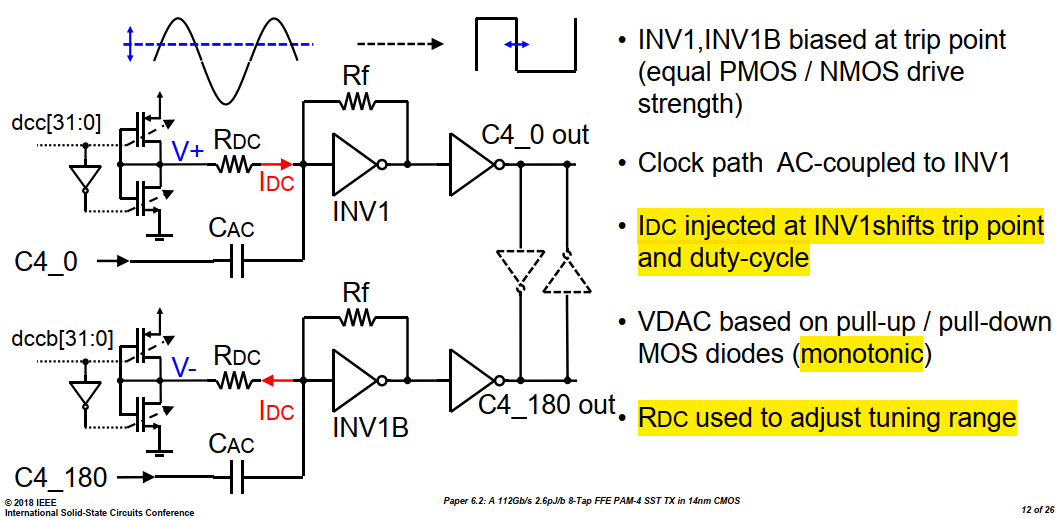
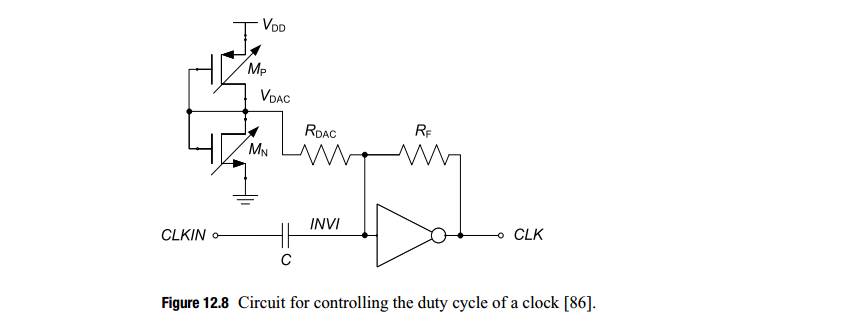
voltage at INV1 will increased by: \[ \frac{\Delta V_{DAC} - \Delta {INV1}}{R_{DAC}} = \frac{\Delta {INV1} +A_0 \Delta {INV1}}{R_{F}} \] therefore \[ \Delta {INV1} = \Delta V_{DAC} \cdot \frac{R_F}{R_F+(A_0+1)R_{DAC}} \approx \Delta V_{DAC} \cdot \frac{R_F}{A_0R_{DAC}} \]
If \(R_{DAC} = R_F\) \[ \Delta {INV1}\approx \frac{\Delta V_{DAC}}{A_0} \]
C. Menolfi et al., "A 112Gb/S 2.6pJ/b 8-Tap FFE PAM-4 SST TX in 14nm CMOS," 2018 IEEE International Solid-State Circuits Conference - (ISSCC) [https://sci-hub.se/https://doi.org/10.1109/ISSCC.2018.8310205]
Bob Lefferts, Navraj Nandra. SNUG Israel 2007 [https://picture.iczhiku.com/resource/eetop/whKYwQorwYoPUVbm.pdf]
C. Menolfi et al., "A 112Gb/S 2.6pJ/b 8-Tap FFE PAM-4 SST TX in 14nm CMOS," 2018 IEEE International Solid-State Circuits Conference - (ISSCC), San Francisco, CA, USA, 2018 [https://picture.iczhiku.com/resource/eetop/shiGDYTDYikLlnXv.pdf]
reference
Article (20500632) Title: How to simulate Random and Deterministic Jitters URL: https://support.cadence.com/apex/ArticleAttachmentPortal?id=a1O3w000009fiXeEAI
Spectre Tech Tips: Measuring Noise in Digital Circuits - Analog/Custom Design - Cadence Blogs - Cadence Community https://community.cadence.com/cadence_blogs_8/b/cic/posts/s . . .
Cadence RAK: Deterministic Jitter Measurement using SpectreRF
Frank Wiedmann. Using sampled pxf analysis to simulate deterministic jitter [https://community.cadence.com/cadence_technology_forums/f/custom-ic-design/51605/using-sampled-pxf-analysis-to-simulate-deterministic-jitter]
supply noise sensitivity: PSS+PAC or PSS+PX [https://designers-guide.org/forum/YaBB.pl?num=1376500816]
J. Kim et al., "A 112 Gb/s PAM-4 56 Gb/s NRZ Reconfigurable Transmitter With Three-Tap FFE in 10-nm FinFET," in IEEE Journal of Solid-State Circuits, vol. 54, no. 1, pp. 29-42, Jan. 2019, doi: 10.1109/JSSC.2018.2874040
— et al., "A 224-Gb/s DAC-Based PAM-4 Quarter-Rate Transmitter With 8-Tap FFE in 10-nm FinFET," in IEEE Journal of Solid-State Circuits, vol. 57, no. 1, pp. 6-20, Jan. 2022, doi: 10.1109/JSSC.2021.3108969
J. N. Tripathi, V. K. Sharma and H. Shrimali, "A Review on Power Supply Induced Jitter," in IEEE Transactions on Components, Packaging and Manufacturing Technology, vol. 9, no. 3, pp. 511-524, March 2019 [https://sci-hub.st/10.1109/TCPMT.2018.2872608]
H. Kim, J. Fan and C. Hwang, "Modeling of power supply induced jitter (PSIJ) transfer function at inverter chains," 2017 IEEE International Symposium on Electromagnetic Compatibility & Signal/Power Integrity (EMCSI), Washington, DC, USA, 2017 [https://sci-hub.st/10.1109/ISEMC.2017.8077937]
Yin Sun, Chulsoon Hwang EMC Laboratory. Improving Power Supply Induced Jitter Simulation Accuracy for IBIS Model [https://ibis.org/summits/aug20/sun.pdf]
High Speed Communications Part 8 – On Die CMOS Clock Distribution. [https://youtu.be/nx5CiHcwrF0?si=-eSO-LaaaFrVuIA1]
Low-Jitter CMOS Clock Distribution [https://youtu.be/LMT-T41Y64U?si=y8IpWCtU90zpe4Ob]
Mo, Xunjun & Wu, Jiaqi & Wary, Nijwm & Carusone, Tony. (2021). Design Methodologies for Low-Jitter CMOS Clock Distribution. IEEE Open Journal of the Solid-State Circuits Society. 1. 94-103. 10.1109/OJSSCS.2021.3117930. [https://ieeexplore.ieee.org/stamp/stamp.jsp?arnumber=9559395]
Mozhgan Mansuri. ISSCC2021 SC3: Clocking, Clock Distribution, and Clock Management in Wireline/Wireless Subsystems [[Clocking, Clock Distribution, and Clock Management in Wireline/Wireless Subsystems](https://www.nishanchettri.com/isscc-slides/2021 ISSCC/SHORT COURSE/ISSCC2021-SC3.pdf)]
Phillip Restle. ISSCC2021 SC4: Processor Clock Generation, Distribution, and Clock Sensor/Management Loops [https://www.nishanchettri.com/isscc-slides/2021%20ISSCC/SHORT%20COURSE/ISSCC2021-SC4.pdf]
Sam Palermo. Spring 2025 ECEN720 : High-Speed Links Circuits and Systems [Lecture 14: Clock Distribution Techniques]